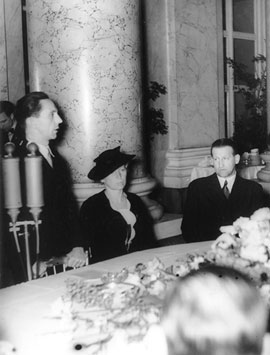
Kurt Martin (1899-1975)
Kurt Martin was director of the Kunsthalle Karlsruhe until 1956 and as general director of the Upper Rhenish Museums responsible for the Museums in occupied Alsace 1940 to 1945. From 1965 he headed the commission of specialists deciding over the distribution of the remainders from the Munich Central Art Collecting Point.
See:
Möbel-Aktion ("Furniture Action")
Under the code name "Furniture Action" or also "M-Action" (abbreviation for "Möbel-Aktion"), the "Einsatzstab Reichsleiter Rosenberg" looted approximately 70,000 homes since early 1942 of French, Belgian, and Dutch Jews who had either fled or had been deported. The objects of art from these homes were inventoried separately, photographed, and transported to Germany. Alfred Rosenberg, who also became "Reich Minister for the Occupied Eastern Territories" as of July 1941, wanted to furnish German administrative offices in the East with the confiscated furniture and other items. In fact, bombed-out families in Germany mainly profited from the looted furniture.
In Paris alone, the "Einsatzstab Reichsleiter Rosenberg" combed through 38,000 homes. A Parisian department store served as an interim storage space before the looted furniture was transported to Germany.
See:

Monuments, Fine Arts & Archives-Section (MFA&A)
This separate art protection unit was established by the Allies in 1943 to trace, recover, and secure stolen artworks.
Kajetan Mühlmann (1898-?)
After the invasion of Poland, Göring appointed Kajetan Mühlmann, an art historian with a Ph.D., as "special representative for securing art treasures." A "Mühlmann Department" performed a similar function in occupied Holland. Through Mühlmann, Göring managed to gain first rights to many of the looted art collections. Mühlmann managed to elude prison after 1945 and lived the rest of his life in-cognito in southern Germany.
See:
Museums
As state institutions, museums and their staff were institutionally involved into the state-organized confiscations of Jewish property – regardless of their individual behavior. Many of them took advantage of the provided leeway to enlarge their collections at the expense of Jewish owners or to receive alleged German cultural assets from occupied neighboring countries.
After the war the museums stylized themselves as victims. Losses in their collections due to the war or due to confiscations in conjunction with the "Degenerate Art" campaign promoted this attitude.
The foreign currency offices supervised emigration and the transfer of assets. The Jews who emigrated were required to pay a "export levy" based on the value of the property they took with them. In order to determine the extent of an "export levy," the value of the artworks among personal effects had to be assessed. Local museum directors were named appraisers ex officio, who could also delegate these tasks to staff members.





